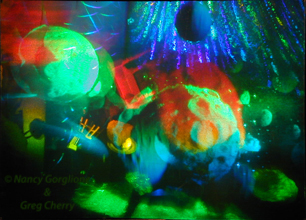
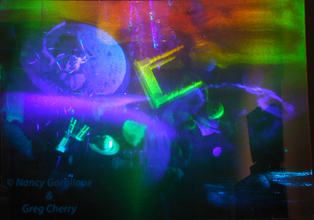
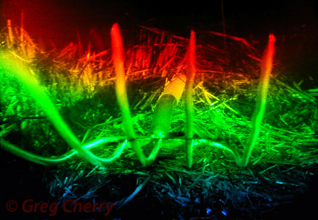
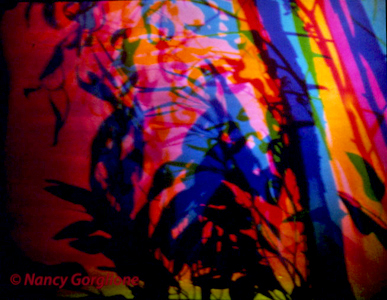
NOW AVAILABLE AS A SELF-CONTAINED HOLOGRAM
Apple Blossoms and Butterfly by Nancy Gorglione and Greg Cherry. Open Aperture Image-plane transmission hologram. Open aperture transmission holograms have a full parallax view, while the color dispersion makes the holographic objects appear as black (blue) and white. In white light, depth beyond a few inches appears as a rainbow spectral smear along the object edges. Originated by Gorglione and Cherry for Lawrence Hall of Science, UC Berkeley exhibit, "Holography: A View in Three Dimensions." This long-standing exhibit, (1986-1998) developed by Cherry Optical Holography, demonstrated 19 different variations of holography with 30 examples.
Space Shuttle FAO Schwartz Hologram by Nancy Gorglione and Greg Cherry. Rainbow and Open Aperture transmission hologram for FAO Schwartz toy store in New York City. Three holographic channels give three views, each originated from multiple Masters and sub-Masters. The sub-Masters are holograms within holograms. Variable lights let the viewers choose the holographic action.
Video of Molecular Rain Transmission Hologram by Nancy Gorglione and Greg Cherry. This hologram is also pictured at right. All rights reserved by the artists.
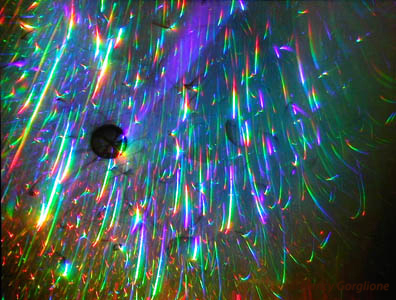
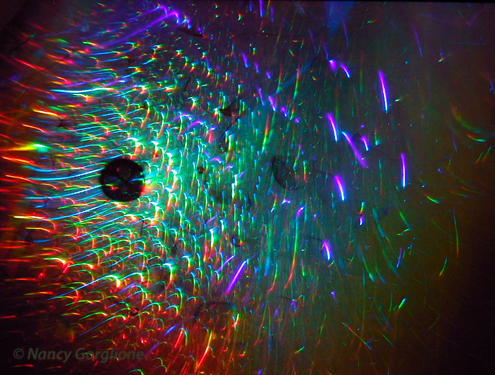
Some Transmission Hologram Art, Technology, History, Inspirations
ruminations and a few reflections.
by Nancy GorglioneCopyright Nancy Gorglione 2017
Transmission holograms transmit the viewing light.
They are usually clear film windows into the holographic space,
with beautiful additive color mixture. The illumination light for transmission holograms comes from the back of the hologram. If mirror-backed, transmission holograms can be made to reflect the viewing light from the front. Those small embossed security holograms are mirror-backed transmission holograms.
More transmission holograms are listed under Cherry Optical Holography Holograms.
Dennis Gabor conceived of holography on Easter morning in 1947. He went on to receive the Nobel prize for the discovery that interfering phase-matched wavefronts of light can record a three-dimensional image. Gabor was attempting to image atoms through a form of holographic microscope. With the development of the laser in the early 1960’s, Gabor’s ideas became exciting research for scientists such as Leith and Upatneiks at Ann Arbor, Michigan. Both pulse lasers and, a bit later, continuous beam lasers offered a pure light able to record an object in three dimensions. Since the laser is a single frequency, or number, of color of light, and is coherent in both time and space - its wavefronts can interfere constructively to record the holographic image.
Greg Cherry's laser scanned Zone Plates illustrate circular
wavefronts of light.Leith and Upatneiks developed off-axis holography. Gabor conceived a single beam of light illuminating the object, then continuing on to a piece of holographic film. Leith and Upatneiks began the development of off-axis holography when they optically split a laser beam into two beams, which were spread by lenses. One portion of the laser beam bounced off the object to hit the holographic film. The other portion of the split laser beam was spread to evenly illuminate the film. The in-phase, matching peaks or troughs of the laser light interfered constructively when they met at the film.
The following illustration describes a copyright-protected Transmission Hologram Set-up, from "The Archives of Cherry Optical Holography:
If You Can See It, Its Not There."
The positive interference of the beam results in an amplification of the wave fronts, which starts a chemical transition in the holographic film. Early (as well as contemporary) holograms are often recorded on silver halide photographic films. These are similar to black and white photo film, except the grain of the silver is very small. The silver is bound with a halide (that which burns) commonly bromine, which activates a chemical transition - exposing the holographic grating into the film at all the points where the two laser wave fronts interfere constructively on the film. The interference of the in-phase waves of laser light (eventually) result in a diffraction grating - our hologram. Interference and Diffraction are the basic mechanisms of holographic phenomena. The holographic view is diffracted light.
Gorglione fashioned a hand out of wax as the object for a transmission hologram, pictured above. The Hand transmission hologram was then used as a Master for a reflection hologram.
What is Holographic Art? Most viewers, unless they are very young, invariable ask, "What is it? and, "How is it done?" (Everytime I answer this question I phrase it in a different way. Throughout this website, you may find a variety of definitions of holography.) A Hologram is a three-dimensional image made with a laser beam. A hologram is a three-dimensional diffraction grating, a record of all the positive wavefront interference that took place during the exposure. Exposure lengths can be relatively long, from a few seconds to a few minutes for holograms made with the most common helium neon lasers. (Red 632 nm.; argon green 514 or 488 nm.) The object must remain stable in continuous wave holography for positive interference of matching wavelengths to occur. This necessarily limits the subject matter of a hologram. Transmission holograms are somewhat easier to make, as the exposure times are less. Transmission holograms are often plane interference gratings, which means the diffraction matrix is usually along the surface plane of the film.
Art Leads Science and Technology Goes Out to Create the World
Holography is the only art media that got thoroughly researched first in government-funded science laboratories and corporate environments, a ten year look from the development of working lasers until the opening of the San Francisco School of Holography, from whence I originally learned the basics. In the early days of exploration, scientists grabbed objects which presented good opportunities to explore the holographic recording process. Chess pieces, trains, and bleached skulls became the early icons of holographic science in the West. Each offered smooth reflective surfaces which would scatter the maximum amount of object light onto the holographic film. Another truism of Holography up until recently was that there was "never enough laser light," which also limited object choices.
Skull Transmission Hologram Master by Nancy Gorglione. (originated for a Global Images Video on Holography. All rights reserved, 2017)
The Art Movement of Holography in the Western World developed into three of four distinct regional variations. First was California Holography, where Lloyd Cross, research associate at Ann Arbor with Leith and Upatneiks, and an early laser scanning engineer, joined light sculptor, Jerry Pethick, to set up the School of Holography. Their sand table vibration-isolation holographic camera systems were set up at Pethick's studio at Project One, a cooperative artists' live-work warehouse in San Francisco. With help from Project One's Hugh Brady, a move was made to a former Wonderbread white bread factory, a large warehouse on Shotwell Street in San Francisco. There, Lloyd and Jerry introduced their sand table method of vibration isolation to neophyte holographers, eventually from around the World. Since holograms are records of the positive interference of wavefronts of light, so small that they were literally counted in angstroms, (or atoms), isolating vibrations within the camera system and its site were crucial to the successful hologram. The sand table was coexistent with the dipsy-dumpster diving approach to reclaiming surplus laser technology from out back of corporate Silicon Valley, down the road from San Francisco.
Holograms, School of Holography Instructors Rota circa 1976,
from the files of Laser Affiliates/Cherry Optical HolographyIt was a highly creative time to be an artist, or an engineer, or a scientist in California, with the Hippy Movement still very much alive and offering cultural support for the sheer freedom of pure creativity. Lloyd, Jerry, and Michael Kan's first students went out to proliferate the words of art holography to waiting artists seeking basements everywhere, but mostly in California: New York and environs: the greater Chicago area and Lake Forest, Illinois... Germany; Great Britain; Japan. Holland, then France and a bit later Korea started making holographic waves, with artists' studios and large exhibitions. At a certain point there appeared to be holographic art galleries or collectors around the World. A few scarce sightings of golden-hued Denisyuk reflection holograms on fine resolution holographic plates hinted at holographic art under the Soviet experience... There were spontaneous arisings of holographers everywhere by the Mid 1980's, but the School of Holography's students can be argued the precursors and proselytizers of this Art Movement. We are still the artists and teachers of holography today.
Three years of Holography Workshops, Work Intensives, and Media Lectures with Nancy Gorglione- California Arts Council Artists in Communities Program, 1982 - 1985
Anthropologists and Geologists mark us now at the end of our World's current aeon - the Holocene. The notions and concepts of holography have birthed many events and objects and people also described by variants around the name, Hologram, like the archetype, Princess Leia - the World's first great "well we wish it were a hologram." From movies projecting pseudo holographic sharks to holographic screens projecting movies, the list and uses for the moniker of Holo.... could go on and on. Sad are the ones that describe near mass extinctions, such as Central Asia's Holocene and the better know Holocaust. (And, now, maybe, the mass extinctions of the eon of Holocene.) It's the HOLO SCENE that is our field in the holographic landscape of the eon of the Holocene. In the United States, the 1950-s to early 1970's has repeatedly been called our Golden Age. We, the followers of Lloyd and Lippmann, we are THE Holographic Artists of the Holocene. While men seem to be getting the Historical credits, the female Holographers prolifically rocked the media into a new way of seeing. The sheer beauty and potential for whole new avenues for expression separates Holography: The Art Media from its better know sharers of nomenclature.
My first holography studio was a collaborative venture with some of the instructors from the School of Holography, that morphed into the early holography company, Celestial Holograms. Lon Moore invited Dave Harrell and I to share in a holography studio on Second Avenue in San Francisco. Fred Unterseyer built a basement wall enclosure, then departed to a warehouse locale in Oakland which became Holografix. John Fairstein, and later, Randy James, also participated in Celestial Holograms, where we had a line of 4 by 5 inch reflection holograms on glass plates. Most of the earliest reflection hologram images used mercuric chloride bleach and did not last. Fortunately, many subsequent holographic processing techniques appear archival. I did a personal series while at Celestial Holograms. I shot a box of 10 plates, 4 by 5 inches ( 10 plates cost $12!) of diffraction grating effects. I believe the chemistry for processing included potassium iodide, which is archival.
Early Diffraction Grating Hologram
by Nancy Gorglione, Celestial Holograms, 1973/4. SF.Open aperture transmission and off-axis “straight” reflection holograms were the most common types of early holograms as they were easily viewable in white light. Next came Transmission Hologram Shadowgrams, where a shadow of an object becomes the object. Holographic Diffraction Gratings were also amazing little slips of holographic light magic. Light itself often became the object for the hologram.
Holograms made specifically as optical components are called HOE's for Holographic Optical Elements. The first wave of holographers frequently made holograms to use as optical elements in the making of further holograms. The first Holographic Screens, which today masquerade as the entire media, where holographed as light diffusers and backdrops for objects in holograms. How many other future treasures are hidden within the diffractive matrix of early holograms?
Greg Cherry's Point of Light Holographic Optical Element made as a reflection hologram. 4 by 5 inches, Novato Garage Lab, 1979
All holograms are technically diffraction gratings, as the viewing light is bent or diffracted on the path of the original object by a series of diffractive matrices recorded in the holographic emulsion. With The Holographic Diffraction Grating, the object of the hologram is pure light. Using modulated laser light as the object, kinetic storms of flowing or roiling waves of light can splash out in a universe of holographic colors at the viewer. In Other Worlds, (bottom of linked page and video) by Nancy Gorglione, is a holographic diffraction grating which has about 14 inches each of depth and projection. True to Gabor’s earliest desires for the hologram, the symmetrical holographic diffraction of laser light can mimic molecules and atoms. It seemed the perfect visual correlation (along with laser light itself) to the visual experiences offered by the psychedelic mind exploration rife in San Francisco during those heady days.
Newton's Smile used in Adam's Ease (Atom's Ease) and The Legend of the Hour reflection hologram composites by Nancy Gorglione (private collections).One of the early "Art" subjects for holographic artists was the apple. There was a fervent wish amongst Holographers to develop art objects that fit the criteria for both Art with a capital A - in part compensation for impatient critics and inertial collectors - while obeying the rigid technical boundaries of the early media. After a holographic table was set up in the basement of the NY Museum of Holography, Posy Jackson and Steve Benton made a hologram of an apple as a calling card for the Museum. Randy James also did a triptych of: a whole apple; an apple with the bite out of it; and an apple core. I holographed the apple smile for a smaller composite hologram as a salute to the archetype of apple. (This is a big archetypal example of art leading technology...) ((The Beatles company, Apple, holds the trademark, for which Apple Computers eventually paid them royalties...)) (((The ultimate archetype for apple, probably established in the Garden of Eden, is the apple-shape of the electro-magnetic field around the heart...))).
Ultimately many California Holographers transferred their holographic cameras to steel-toped isolation systems which allowed positioning of magnetic bases for the optical components. This change allowed Holographers to optically open up the aperture of the holographic view, gaining greater angle of view and parallax in the finished hologram. Parallax is the ability to see around objects to objects placed behind. The increased stability of magnetic optical systems also encouraged the relative proliferation of all variations of reflection holography in California. Small private enterprises in the American West such as Coulter Optical Company ground and coated front surface telescope mirrors, which worked very well for collimating the reference beam when making a hologram. This encouraged Image-Plane Reflection Holography, which allowed reflection hologram copies to be made from a Transmission Master’s projecting pseudoscopic image.
Vase with Water and other holographic details from Nancy Gorglione's Bouquet reflection hologram composite, 1984. The reflection image-plane holograms were made from Transmission Hologram Masters. Collected for Chunichi Shimbun's World of Holography by the Laser, Inc., Japan.
Surprisingly, flowers became a viable subject for holography. They offered a private tour de force of condensed light on a instable, living object. Overcoming the technical constraint of stability requirements during long exposures appealed to both, holographers' sense of beauty, and, the technically difficult made visible in three dimensions.
So far, all the holograms discussed in this copyrighted article are open-aperture holograms... Meanwhile, on the East Coast Holography scene, Steve Benton calculated the math for color control of his transmission hologram "Masters," made with a narrowed vertical "slit" aperture. These Benton or Rainbow Transmission Holograms have full horizontal parallax and little vertical parallax. Benton Rainbow holographic images can project a meter or more in front of the hologram. Instead of vertical parallax, a rainbow spectrum is visible as the viewer moves up and down. This process eventually allowed Cherry Optical to make large colorful transmission holograms with great depth and projection of the holographic imagery. Beautiful additive color mixing, and especially, projecting light images out in space began to fulfill the science fiction-fed expectations that burden holography.
My first husband, Jeffrey W. Milton, was a holographic messenger from the East Coast, bringing California’s former students of the School of Holography, and their students, both Benton's Rainbow math, and, Nick Phillip’s very British chemical processing formulas. Phillips' most important bleach formulas re-halogenated the silver halide bromide of the developed hologram, turning it back into a crystal-like diffractive matrix that made the resultant hologram superior in brightness. The hugely influential first edition of the L.A.S.E.R. News published both Phillips’ PBQ formula and Benton’s math; along with J. Kaufman’s formulas for color control in reflection holography. Holography had fully arrived as an Art Media, although the high cost of bright lasers and equipment slowed creative development.
White Moire' by Nancy Gorglione, Multicolor Reflection Hologram. 1981. San Francisco State University Physics Department Lab. Nancy Gorglione, with guest workshops by L.A.S.E.R. members, taught an Introduction to Holography Course in 1980-81, while Dr. Gerald Fisher was Department Chairman.
The Work Intensive approach to creating a hologram was an essential component of making a successful hologram. One of the most valuable things I learned in my tenure with Lloyd Cross and friends at the School of Holography was the essential ethic of the “work intensive” where long work sessions with co-participants totally focused and committed to the outcome of making a hologram. Hard work, and Zen-like patience standing around the chilly basement optics table in the dark with strange lights for long hours was part of the process. Cherry Optical’s early holographic lasers, (pictured at the bottom of Laser Art) from Spectra-Physics, Inc., and Coherent, Inc., needed both 220 3-phase electricity (our electrical provider dug holes and strung 14 electrical poles to reach our studio) and plentiful water-cooling to dissipate heat in the glass laser tube. We have a truck radiator mounted out back with a big fan to cool the circulating water, which the modern generation of lasers has rendered obsolete.
Lloyd Cross holding his son's laser scan image. Photo by Greg Cherry
The Archives of Holography article by Lloyd and Cecile Cross describes a table-top holographic display at a 1973 medical convention where Lloyd Cross and Steve Benton were seated next to each other - Lloyd, with his first multiplex stereogram holograms. Steve Benton had a white light rainbow hologram displayed on the same table. I like to imagine that they took a break out back, then returned to the holo display to be dazzled and inspired by each others' work. Together they realized that a combination of the two techniques would result in white light viewable integral holograms.
As the result of a few serious work intensives at the School of Holography, the Multiplex Hologram, and then, the Multiplex Company, were born. In a Multiplex Hologram, successive film slits of a moving event became the projected holographic object information. This ultimately opened the doors to digital transmission holography, where bytes of information replace the transmission slit holograms. Today, digital integral or types of Multiplex Holograms put some of the work of making these types of holograms on your laptop.
The Multiplex Company "Co-operatively employed" or spun-off independent holographers from behind the scenes, including Sharon McCormick, who made her own Multiplex Machines, some with Michael Kan, who taught everyone how to make these machines, complete with liquid lenses. Michael Kan was a empowering teacher at the School of Holography and later, the Multiplex Company. When you could not hand fabricate a metal part with files as per Michael’s instructions, Bob Tauton and his machine shop were on hand; while Multiplex’s David Schmidt had at least two warehouses full of useful parts and equipment to search through if you could not fabricate what you needed. Rufus Friedman, Laura Schneider, Linda Cecere; Gary Addams; Peter Claudius and others were all working parts of an early Holo Scene... At one point I remember Lloyd calling the group a "bunch of money-hungry Hippies" as they sought organization and success.
Once-again, this puts lie to some of the misappropriations and malapropos laid at the (bare) feet of the Hippies, who in reality produced more innovations leading to more wealth than any other group in History. What other Record Keepers of the era miss was just how broke, or poverty stricken, many of the early Holographers were. However: Rent was cheap, food was cheap, and cultural innovation was (sort of) encouraged; crucial differences from today. It was beyond "necessity as the mother of invention." Times were magical and solutions could be seemingly plucked from thin air.
In looking back, I realize that there were several Holo Scenes just in San Francisco! The aforementioned downtown San Francisco-Mission District Holo Scene, centered around the School of Holography and Multiplex Company; and, the Haight Ashbury- Golden Gate Park centered Holographic Artists, individuals or small groups mostly operating hard won basement or garage private Holographic Studios. Holografix operated a coop holography studio-warehouse space in Oakland, CA. Then, there were the Holographers of the Laser Tech Companies in the Palo Alto-San Jose Area, itself on the way to becoming Silicon Valley. The different groups (with some overlap) met quarterly at the holographic art openings produced at Holos Gallery in the Haight Ashbury. In its first year or so of operation in the later 1970's, Holos Gallery introduced the work of New York's Holographers to the SF Bay Area. We all met over bottles of wine and copious cheese platters to soak up the inspiration.
As mentioned, it was a hugely inspirational time to be alive in San Francisco. I do not recognize the many written descriptions of the post-1967 Haight Ashbury. The Hippies did not die out, they cut off their hair and journeyed with open hearts across the City and probably the whole Universe. It was not uncommon to continue the creative excitement of Holos' Openings downtown, where one night the plush Herbst Theatre let a crowd of us in free to hear Steve Reich and musicians play Music for Six Marimbas. Another post Opening found us dancing wildly, feet tattooing percussive waves on the upper story wooden warehouse floor of the Deaf Club, where the hard-of-hearing heard the musical beginnings of Punk Rock through the resonance and vibrations shaking the place. Music and art fed the soul through a significant number of small art businesses, exhibition spaces and galleries, both in the Haight Ashbury and throughout the City. The Sixties didn't really end until the Eighties...
Nancy Gorglione, Jody Burns and Rudy Berkhout at opening for California Color, New York Museum of Holography, photos by Patti Negro Milton, design by N Gorglione
Jeff Milton moved back to New York to work for Jody Burns, another early School of Holography student. In 1985, I married Greg Cherry and we started Cherry Optical Holography. For all too few years we were able to make a living with holography, which has basically been a labor of love supported with other work.
Greg Cherry experiments with Integral - Holograms by making multiple-slit Transmission Masters of real time moving three dimensional objects. He then copies the resulting object information as image-plane reflection holograms, or transmission holograms. Greg Cherry is one of a handful of California Holographers who learned holography independently from The School of Holography. A introductory article in Popular Mechanics Magazine inspired him to set up his first holography studio in a spare room. In 1981, Greg moved to our present location, where we've literally built the walls of our holography studio around empty basement space.
Today, Greg Cherry's digital Transmission Masters are derived from a moving camera rail which sequences its view frame by frame. The resulting digital video images are edited, and then projected as object light for the Transmission Master. (This is really prototype, not ready for the marketplace. We call them Cherry Optical Holography's Primitive Digital Holograms.)
As Leith and Upatneiks Knew: "All Waves Obey All Ways" (Quoting Eclair)
It is commonplace to picture Leith and Upatniks in a school basement laboratory, but actually they had a city-block full of buildings for their electromagnetic wave research, funded in part by the military. As we now know, all waves obey all ways. All size electromagnetic waves, from microwaves to X-rays to the visible spectrum of color, can be made to "obey" laws of positive and negative interference.A laser company engineer came to me one day in about 1978 and said that the laser tech companies were going to begin manufacturing medical equipment. (Would that I had said a big "NO!") The CT Scan uses the principles of Lloyd Cross's Multiplex hologram, only its slits are overlapping X-rays exposing your body to an interior sort of holographic view. (Today it is a useful, but perhaps overused and extensively radioactive diagnostic test. Hence the big NO.) Anyway, I digress, as the CT Scan when used correctly is a perfect example of (holographic) ART leading science and technology as is essential to a highly developed civilization. So how do I get us back to the sheer freedom of creativity?
Lightscapes Brochure Description from SF Arts Festival/SF Arts Commission
In the US, the cross fertilization of holographic technology West to East and then back again enjoined the early holographic community in a solid sense of co-operation, rather than competition. The Laser Arts Society for Education and Research, (L.A.S.E.R.) a non profit organization which grew out of Laser Affiliates, was started in 1979 by myself and Gary Zellerbach, owner of Holos Gallery. Our first Board of Directors were: Nancy Gorglione; Gary Zellerbach; Fred Unterseher; Randy James; Vince DiBiase; Bruce Goldberg; and Steve Anderson. For a period of time, there was unity amongst holographers in promoting our work. We organized early holographic exhibitions, especially Lightscapes, which eventually toured West Coast science institutions.
The very first holograms were Gabor single beam transmission holograms originally created with one of the first Ruby-pulsed lasers. Pulsed lasers can capture the movements of human subjects in a single pulse of laser light. Some of the early Ruby crystals occasionally lased multiple pulses... Two or more pulses in rapid succession can be used to record holographic fringe patterns in what has become the industry of Interferometry. Essentially each pulse creates a hologram, and the differences in the phases of subsequent pulses, and their reflected light off the object create fringes. Echo Reflects (pictured below this scroll box) by Nancy Gorglione is an example of a colorful transmission interferogram hologram, in this case the multiple exposures originated from a continuous-wave laser.
Cherry Optical Holography's Laser Chakra Device, 1996 re-engineered 2008
An early holographic researcher, Ralph Werker from TRW, another California company, conjectured the use of pulsed laser interferometry for medical diagnostic purposes in the 1960's. In The Holographic Universe and with Cherry Optical Holography's Laser Chakra Device, (1996) laser - optical interferometry is proposed for use in Vibrational Medicine. There's a Scottish patent for laser interferometry employed in a vitamin company to boost the molecular resonance/strength of the vitamins. On the other end of the research spectrum, researchers today prototype femtosecond lasers (at Leith and Upatneiks old lab!) used in processes akin to hard X-ray Diffraction Holography at linear and ring accelerators such as Stanford's Linear Accelerator. (I think they may have to remake the optics every time they fire off a hologram.)
Many early holographic speculations seem amazingly prescient today. By the time inventors such as Jody Burns, Steve McGrew, and Steve Provence perfected embossed (transmission) holography in the early 1980's, our Movements in Art Holography had differentiating characteristics:
Poster From Laser Affiliates Presents San Francisco Holography: A Major Exhibition of Fine Art Holography, featuring holograms by Greg Cherry, James Feroe, Nancy Gorglione, Bob Hess, John Kaufman, Randy James, Lon Moore, Jeff Murray. Silkscreen Poster by Jos Sances.
A very brief and incomplete return to the Holo Scene of Art Holography
California Holography saw the origination of beautiful color control in reflection holography. There were a significant number of holographic artists in California with their own Laboratories and Holographic Studios, and color control was one unifying artistic preoccupation that resulted in a Movement's worth of really beautiful holograms. The San Francisco Holography Exhibition in 1985 (poster above) featured color control in reflection holography, with the works arranged thematically. Both techniques and holographic subject exploration showed the cohesiveness of a a fully formed holographic movement.
The pursuit of color within larger format transmission holograms on film was another early California Holographic Preoccupation. Greg Cherry and I envisioned Sculpture made from some of the first large format transmission hologram arrays in Equus/Underwater, A Holographic Stageset.
There was New York-East Coast Holography, when holographers such as Dan Schweitzer and Sam Moree, Rudy Berkhout, Jody Burns, (Dieter Jung/Germany, working in Jody's NY Lab) and others created light jewels of intricate transmission Rainbow-Benton holograms. The financial and spiritual support of such collectors as Jerry Miller and the Museum of Holography with Posy Jackson were essential to the development of the New York holographic scene.
The waves of science and art met at the tri annual summer holography conference at Lake Forest College near Chicago, Illinois, organized by Dr. T. Jeong, with Virginia Crist. Science, industry and art met in a semblance of sharing of information and techniques. Chicago also had both, the Chicago Museum of Holography, directed by Loren Billings who presented large holographic exhibitions and developed a sizable collection of Art Holography; and The School of the Art Institute of Chicago with Ed Wesley.
Entrepreneurs such as Mattias Lauk in Germany helped create both audience and the industry of holography in Germany, exhibiting holograms in diverse venues from museums to shopping malls.
Pulsed holography, always around, became more accessible to artists through the development of non profit or commercial labs in San Francisco; Chicago; New York and Canada later on in the late 1980's. The British breached Holography early with pioneering work by Margaret Benyon and others, whose mature work explored California techniques in color control. When the British set up a pulsed-laser Holography program at the Royal College of Art, Peter Miller from Holografix in Oakland, CA, (started by Fred Unterseyer after his stints with Celestial Holograms and the School of Holography) became the first instructor.
Dark Waters, reflection hologram by Cherry Optical Holography. The red light illuminated Hand, above,was one projected Master for this image-plane reflection hologram. Approx. 20 by 24 inches.
I suspect California’s technological revolution and the holographic whole was a scarcely recognized Golden Age of Art. Yet, at the time of this writing in 2017, it is ever difficult to remain positive and optimistic about the Art of Holography. As holographic art originator, and conscious participant in an art movement, events happened to me and around me that were analogous, even archetypal forces for the larger events that now have our World in their grasp. Never a dull moment in phenomena... One of Niahl Ferguson’s astute history books, Empire, looks at the British Empire, and the colonization of America. Here simplistically described, he explores the flow of materials and ideas, originated from the later acquired US Colony of California, to the original 13 Colonies on the East Coast, then eventually back to the British Empire. A historian could explore the origins and subsequent machinations of Holography within this context of Empire: the people, the schools, the money, the egos, the flow of goods back to the Grandmother Ship. What began as Freedom of Creativity and Consciousness Meeting Technology all too quickly dissolved into a competitive rout.
In a Golden Age, Art leads Science and its Technology, but within holography it eventually was as simple as having a large Middle Class for holographic art to gain fervid supporters. I am unsure of the numina or meme that art must serve defense, as literally happened amongst a Russian cultural committee during the waning days of the Soviet Union. All funded art production was to be directed to defense... The adverse, or reverse, might be defense used in the name of art, as Drone-carried laser light shows become the next generation of laser illuminations.
!
Ten and A-Half Point Star Diffraction Grating Hologram by Cherry Optical Holography.Holographing Mountains
TimeLoveTime LOVE by Nancy Gorglione and Greg Cherry, partial parallax view of large format transmission hologram for a private installation, 1991
Participation in The Fourth International Biennial-ARTEC ‘95, in Nagoya, Japan, brought me to Asia, and in subsequent years I collected the mountains and lakes of the Himalayas and adjacent ranges. There, I introduced holography and laser scanning to The Autonomous Region of China. With a small laser and some star patterned diffraction gratings, I beamed the Potala; a Big Buddha statue at Samye; and other antique cultural remnants. On one journey, I gave away one hundred holographic portraits, an archetypal image recorded on DuPont photopolymer film. Everybody, regardless of politics or race, wanted one. Art leads Science, but here is a case of art leaving politics behind... On my almost last trip to Asia in 2004, Himalayan mountain taxies had holographically embossed films of “Rainbow Worlds” - in the region's Buddhist iconography - laminated to their windows. You never know how far a laser beam can go. Vast is the Holographic Universe and vast are the workers for peace.
Peace Star, Diffraction Grating Hologram by Cherry Optical Holography.
Light Thru the Trees, by Nancy Gorglione. Rainbow Transmission Hologram and Shadowgram combined.
22 x 30 inches. One of the Stage Front Holograms in Equus Underwater, A Holographic Stage Set from Cherry Optical Holography.
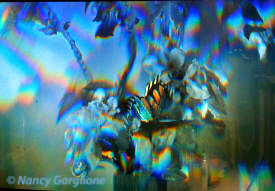
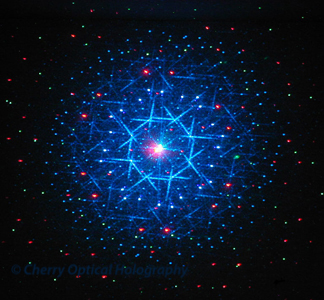
Early Art Movements in Holography
Please email your comments or additions. We realize we may have left out some of your favorite countries! Every holographic artist probably could detail a different list and we look forward to reading it.California Holography - Reflection Color and Technical Control; Large Format Transmission Holograms; Multiplex Holograms; Green Laser Pulsed Holography; Interferometry; Embossed Holography. Technologies from Sand tables to Laser Companies. Many influential artists and technicians. All too briefly, existence of L.A.S.E.R. and Holos Gallery.
New York Holography - Jewels of Light from Benton Rainbow Holography; one generation focused image-plane Transmission Holograms; red laser Pulsed Holography; Embossed Holography, Museum of Holography with Posy Jackson! Collector Jerry Miller. Proximity to Steve Benton.
Chicago and Lake Forest Holography - including the inimitable Lake Forest Holography Conferences organized by T. Jeong and Virginia Crist. The School of the Art Institute of Chicago. The Chicago Museum of Holography.
British Holography - Photochemical innovations, Nick Phillips. Royal College of Art -government support. Exchanges with NY-USA.
Germany - Development of Holographic Market Economy, Matthias Lauk; Holographic Screens. Ongoing research and art education.
Japan - Serious and thoughtful collections, research and some publications.
Russia - (formerly Soviet Union) single beam Denisyuk reflection holograms on excellent high resolution film. Fine Holographic Films and Plates from Slavich.
Switzerland - Holographic Money.
Canada - individual holographic artists tucked away with government, education, and/or small business support.
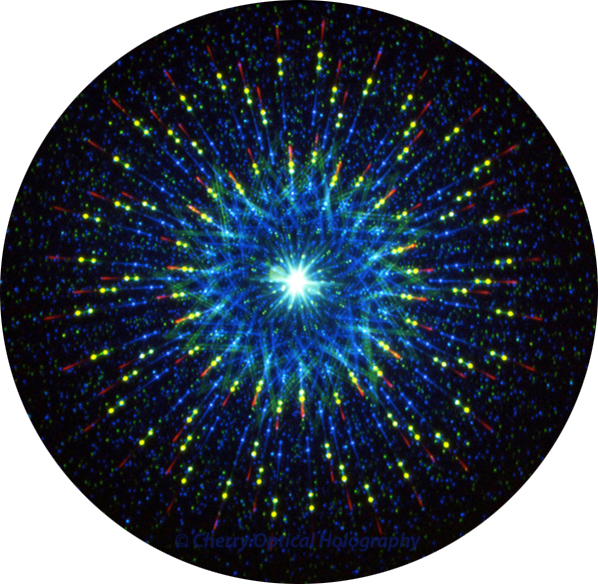
Starburst Holograms by Cherry Optical Holography. Copyright 2017; All Rights Reserved.
One of the definitions of great art is that it encourages explorations (or imitations) which eventually encompass a Movement in Art. We like to think our holograms are inspirational at their best, and directly copied, or misappropriated, at worst. Please take inspiration from this Website and nothing else without our permission.
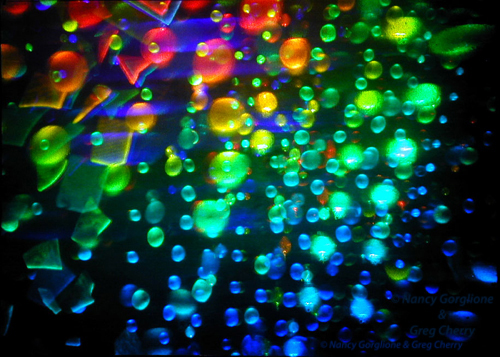
UNIVERSAL HOLOGRAM Home of Cherry Optical Holography Finest holograms by Nancy Gorglione & Greg Cherry
|
|||
A Local Internet History of Our Transmission Hologram Art |
|||
|
universalholo@comcast.net |
All Contents Copyright © 2017 All Rights Reserved by Nancy Gorglione and Greg Cherry |
|